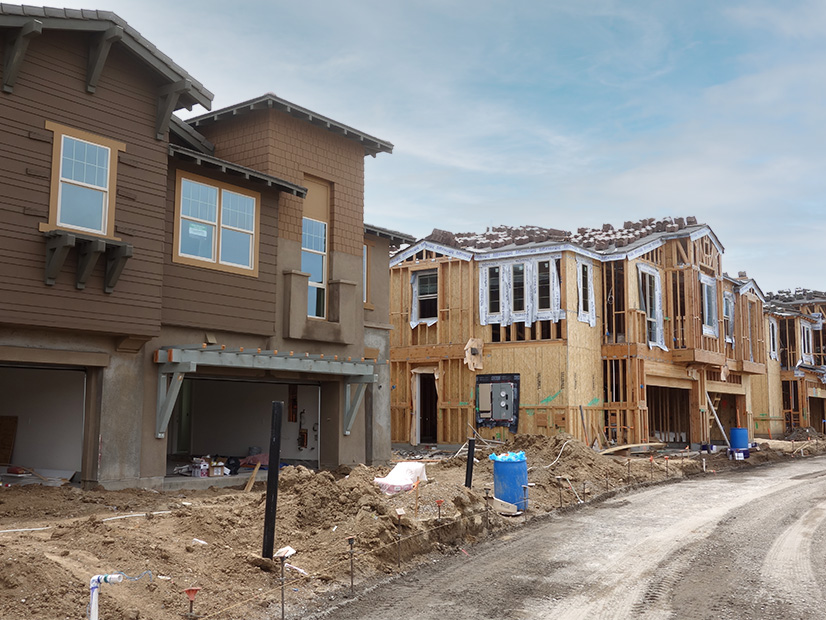Strategies to decarbonize buildings should include speeding up deployment of electric appliances to bring down equipment costs, said a participant in a California Air Resources Board workshop this week.
“At current costs, we just cannot spend our way to retrofitting the entire building stock,” said Pierre Delforge, a senior scientist in the building decarbonization program at the Natural Resources Defense Council. “We have to bring the costs down to make it possible.”
New construction should be one priority area for electric appliances, since new buildings typically need new appliances for space heating, water heating, cooking and clothes drying, Delforge said. Replacement of propane appliances is another opportunity, he said, as the “economic case is very strong” for switching to electric equipment.
Replacement of air conditioning should also be a focus, Delforge said. For “a couple hundred dollars more” than standard air conditioning, someone could install an electric heat pump that provides both space heating and cooling. The same reasoning applies when a resident who has gone without air conditioning decides they now need it due to climate change.
At the same time, the first steps toward accelerating building decarbonization should include low-income communities where residents spend a large share of their income on energy bills and rent, Delforge said.
Delforge’s comments came on Monday during a CARB workshop focused on building electrification. CARB held the workshop as part of the process for developing the 2022 scoping plan, a roadmap for meeting greenhouse gas reduction goals.
Multi-Billion-Dollar Cost
According to a California Energy Commission report this year, the cost to reduce GHG emissions from residential and commercial buildings to 40% below 1990 levels by 2030 ranges from $2.9 billion to $40 billion. Those figures are likely an underestimate, Nick Janusch, an environmental and behavioral economist in CEC’s Demand Analysis Office, said during the CARB workshop.
The building decarbonization assessment, which CEC released in August, was required by Assembly Bill 3232 of 2018.
The assessment outlined seven strategies that could help achieve the 2030 goal. They include building end-use electrification, electricity generation decarbonization, energy efficiency, refrigerant leakage reduction, distributed energy resources, decarbonizing the gas system and demand flexibility.
Regarding the first strategy, the report said, “substituting energy-efficient electric appliances for gas appliances and equipment in buildings can offer efficiency savings and GHG reductions, as well as air quality co-benefits.”
The benefits are especially evident with the use of efficient electric heat pump technologies, the report said.
During the CARB workshop, Janusch said residents’ preference for gas cooking is one of the barriers to transitioning to all-electric buildings. And a neighborhood can’t be decommissioned from the natural gas distribution network unless all the homes go completely electric, he said.
But Janusch said educating residents on the health impacts of gas cooking might help change their minds. Children living in a house with natural gas cooking have a 42% increased risk of having asthma at the time, and a 24% increased risk of having asthma over their lifetime, said a study cited by CARB during the workshop.
Janusch said residents need to plan for electrifying their homes, rather than reacting to an unplanned emergency when an appliance breaks down.
Josh Greene, vice president of Government and Industry Affairs for A.O. Smith, a manufacturer of residential and commercial water heaters and boilers, suggested an assessment of existing homes to gauge whether they’re ready to switch to electric, or whether they need improvements such as panel upgrades.
Gathering the data would allow “viable opportunities” to be targeted now, Greene said.
Homeowner Weighs In
In letters submitted to CARB, some members of the public cautioned against requiring electrification of existing homes.
Resident Michael Brady described his income as “lower middle,” which he said is just high enough to disqualify him from many retrofit incentive programs. He recently spent much of his savings on a new heating and cooling system for his home and the installation of solar panels.
Replacing his gas cooking stove with an induction range would be an expensive project, with a new electrical panel and wiring costing more than the range itself. Incentives might be available for the appliance, but not for the electrical work, he said.
“Please consider the implications on existing building owners when talking about forced retrofits,” Brady said.




